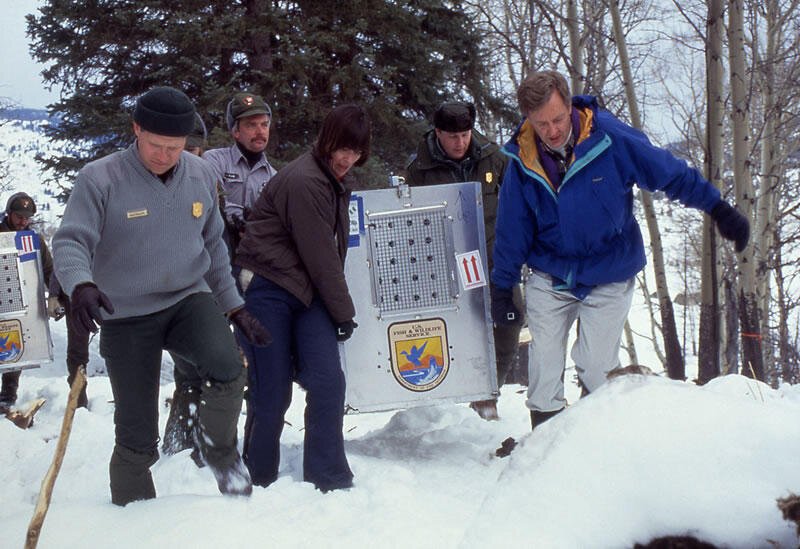
The Yellowstone Wolf Reintroduction: A Timeline
Yellowstone National Park is recognized as one of the best places in the world to observe wolves in the wild.
However, there were times within the last century when wolves were notably absent from the ecosystem. The successful reintroduction of wolves to Yellowstone in 1995 has been celebrated around the world, and by 2017, wolves were considered sufficiently recovered to have been delisted from the Endangered Species Act in Montana, Idaho, and Wyoming.
Explore the history of wolves in Yellowstone and the reintroduction that is considered one of conservation’s greatest success stories
1872
Yellowstone is created as the world’s first national park. Gray wolves are present on the landscape and have a dynamic influence on the health of the ecosystem.
1884
The state of Montana institutes a wolf bounty. Trappers receive one dollar per wolf killed.
1914-1926
Wolves are considered "a decided menace to the herds of elk, deer, mountain sheep, and antelope" (Yellowstone Superintendent Annual Report 1915) and concerted efforts to "exterminate" (Yellowstone Superintendent Monthly Report February 1919) them were mounted. At least 136 wolves are killed in Yellowstone National Park.
1940-1970s
Wolf pack sightings are rarely reported in Yellowstone. Observations of wolf-like canids, mostly singles and pairs, are reported intermittently. It’s believed wolves are almost completely eradicated in the lower 48 states. In the 1970s, an intensive survey finds no evidence of a resident wolf population in Yellowstone, although individuals likely passed through.
1974
The gray wolf is listed under the Endangered Species Act of 1973 (ESA). The ESA:
Establishes protections for fish, wildlife, and plants that are listed as threatened or endangered;
Provides for adding species to and removing them from the list of threatened and endangered species, and for preparing and implementing plans for their recovery;
Provides for interagency cooperation to avoid take of listed species and for issuing permits for otherwise prohibited activities; and
Provides for cooperation with States, including authorization of financial assistance; and implements the provisions of the Convention on International Trade in Endangered Species of Wild Flora and Fauna (CITES).
1980s
Wolves re-establish breeding packs in northwest Montana.
1991
Congress directs the U.S. Fish and Wildlife Service to prepare a draft Environmental Impact Statement (EIS) on wolf recovery in Yellowstone and central Idaho. A draft EIS is a government document that outlines the impact of a proposed project on its surrounding environment.
1994
An Environmental Impact Statement is completed for the reintroduction of wolves into central Idaho and Yellowstone National Park. The chosen alternative reintroduces wolves as an experimental population, which allows for the killing of problem wolves outside park boundaries. More than 160,000 public comments are received—the largest number of public comments on any federal proposal at that time.
January 1995
Two shipments of wolves arrive in Yellowstone National Park from Canada, totaling 14 wolves. The wolves are transferred to three acclimation pens near the Crystal, Rose, and Soda Butte creeks in the park to attune their homing tendencies so they stay in the Greater Yellowstone Ecosystem once released.
March 1995
The gates to Crystal and Rose creek pens are opened and a fence hole is created by biologists to encourage the wolves to leave. By March 31, all of the wolves in those pens have made their way into Yellowstone National Park. Their packs are known as the Rose Creek pack, the Soda Butte pack, and the Crystal Creek pack.
January 1996
Another 17 wolves from Canada are placed in four acclimation pens in Yellowstone National Park. These enclosures were the Crystal Creek, Rose Creek, Nez Perce Creek, and Blacktail pens.
April 1996
Biologists open the gates of the pens. To avoid confusion with previously released packs, the Rose Creek pack became the famed Druid Peak wolf pack. The other new groups included the Nez Perce pack, the Chief Joseph pack, and the Lone Star pair. Wolves are once again at home in Yellowstone National Park.
2008-2017
Over the next several years, wolves are delisted and relisted on the Endangered Species Act in Montana, Idaho, and Wyoming. As of April 26, 2017, gray wolves are delisted in Montana, Idaho, and Wyoming, indicating that they’ve sufficiently recovered and are no longer endangered species in those states.
Present
Since the reintroduction, the wolves have established themselves back in the ecosystem. The number of wolves and packs has ebbed and flowed over the years, but the population currently hovers around a stable 90 to 110 wolves within the park. Approximately 500 wolves are present throughout the Greater Yellowstone Ecosystem.
Wolves are again asserting a positive influence on the ecosystem by playing a critical role as ecosystem engineers in Yellowstone’s natural processes and bringing an estimated $83 million to the park’s gateway communities through wildlife watching. Yellowstone National Park is now one of the best places in the world to view and study wild wolves.




